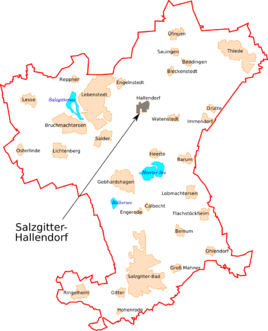Hallendorf (Salzgitter)
|
Hallendorf
City of Salzgitter
|
|
|---|---|
| Coordinates: 52 ° 9 ′ 16 ″ N , 10 ° 22 ′ 35 ″ E | |
| Height : | 101 m |
| Area : | 3.4 km² |
| Residents : | 1682 (Dec. 31, 2019) |
| Population density : | 495 inhabitants / km² |
| Incorporation : | April 1, 1942 |
| Incorporated into: | Watenstedt-Salzgitter |
| Postal code : | 38229 |
| Area code : | 05341 |
|
Location of Hallendorf in Salzgitter
|
|
Hallendorf is one of the total of 31 districts of the independent city of Salzgitter in Lower Saxony . It is located in the east and is one of the larger towns in the city of Salzgitter.
history
Hallendorf was first mentioned in 801. Around 1540 there were about 37 houses there. Hardly anything changed about this until the time of the Third Reich. At the end of 1937, the establishment of the Reichswerke began in the Hallendorf district. Large barrack camps were set up in the vicinity of the village, including the so-called Hallendorf Labor Education Camp , also known as Camp 21 as a special or labor education camp.
Population development

Sources: The population figures from 1821 to 2000 are based on the statistical yearbook of the Department for Economics and Statistics of the city of Salzgitter. The population statistics from 2001 are based on the monthly statistical reports of the city of Salzgitter (residents with main residence) according to the population register at the end of December.
religion
In Hallendorf there is a Protestant church and the Catholic Church of the Holy Spirit .
Evangelical parish
The first construction of the Protestant church was created at the beginning of the 14th century. In 1568 Duke Julius introduced the Reformation . Between 1798 and 1802 the church building was enlarged and received its current appearance. The church has an organ from the organ building company Furtwängler & Hammer from 1896 (Op. 340). The parish belongs to the provost of Salzgitter-Lebenstedt, since 2017 it forms together with the parish of Salzgitter-Watenstedt the parish “St. Barbara ".
Catholic parish
A Catholic parish has only existed in Hallendorf since 1940. Initially, the services took place in the Watenstedter church, later in a local inn. After 1945 an old barrack was used for church services. The new church building was consecrated at Pentecost 1962. The Heilig Geist-Kirche has been a branch church of the parish of St. Bernward in Salzgitter-Thiede since 2006 .
politics
Local council
coat of arms
The cross stands for the stone atonement crosses that were once set up on the edge of the village and which now stand in front of the church. It also symbolizes the influence that church institutions have exerted on the village for centuries and that they have long been among the landlords of the village. The gable above the cross represents a roof or a house and thus symbolizes the term village in the place name. Since 1748, blue and yellow have been the colors of the Duchy and Free State of Braunschweig, to which Hallendorf belonged for a long time.
The coat of arms was adopted as the local coat of arms of Salzgitter-Hallendorf at a meeting of representatives of all local associations on October 25, 1994.
Economy and Infrastructure
Like most of the villages in Salzgitter, Hallendorf is surrounded by agricultural land.
Companies
The Salzgitter steel works are located on the outskirts of Hallendorf . These are among the largest heavy industrial companies in Germany.
traffic
Hallendorf is on the Braunschweig – Derneburg railway line . There used to be a breakpoint here too ; Meanwhile, the trains on the RB 44 line on the Braunschweig – Salzgitter-Lebenstedt route run through Hallendorf without stopping.
education
There is a primary school and a Protestant kindergarten in Hallendorf. The Hallendorfer Werkstätten of the Christian Youth Village Association in Germany are an institution for people with disabilities.
energy
There is a substation for 220 kV in Hallendorf. Immediately next to the substation was a high-voltage test facility of the Technical University of Braunschweig from 1925 to 1975, in which Professor Erwin Marx developed the electric arc converter .
literature
- Church buildings in Salzgitter . In: Department for Public Relations of the City of Salzgitter (Ed.): Salzgitter Forum . tape 12 , 1986, pp. 29 .
- Hallendorf Forays through twelve centuries. In: Archives of the City of Salzgitter (Ed.): Contributions to the city's history . tape 18 , 2001.
- Literature about Hallendorf catalog of the DNB
Web links
Individual evidence
- ↑ Fred Rosenberger: Salzgitter-Bad through the ages . 2nd Edition. tape II . Geiger-Verlag, Horb am Neckar 2002, ISBN 978-3-89264-535-1 , p. 57 .
- ^ Department for economics and statistics: Statistical yearbook of the city of Salzgitter. City of Salzgitter, accessed on February 22, 2020 (total number of eligible residents (main and secondary residence) © City of Salzgitter).
- ^ Department for Economics and Statistics: Monthly Statistical Reports of the City of Salzgitter. City of Salzgitter, accessed on February 22, 2020 (Population at the location of the main residence © City of Salzgitter).
- ↑ A church in front of the chimneys - the church in Hallendorf began in the 14th century , Salzgitter-Zeitung of July 28, 2018.
- ^ Arnold Rabbow: New Braunschweigisches Wappenbuch . Braunschweiger Zeitungsverlag, 2003, ISBN 3-926701-59-5 , p. 36 .
- ↑ Website of the CJD Salzgitter , accessed on May 29, 2018.
- ↑ vde.com: About the development of Marx's electric arc converter



